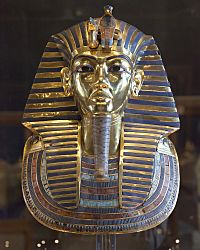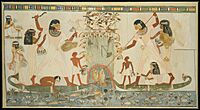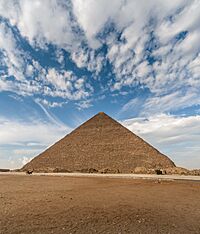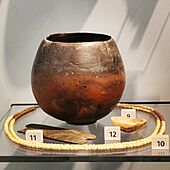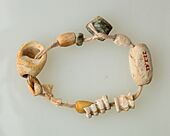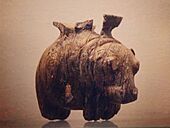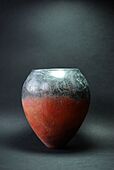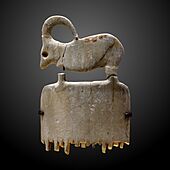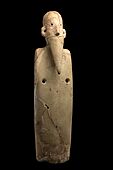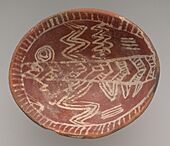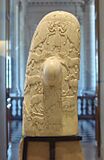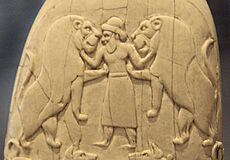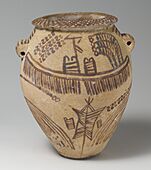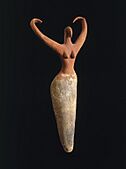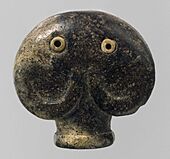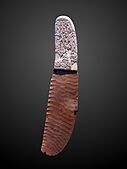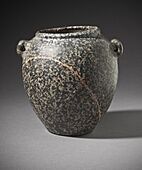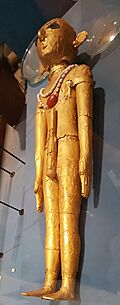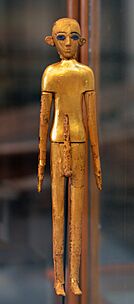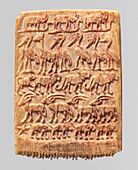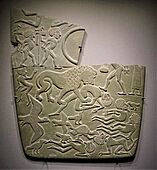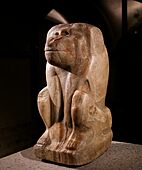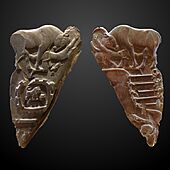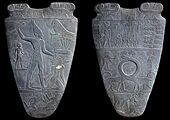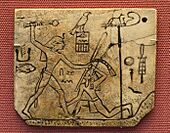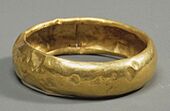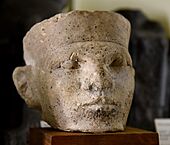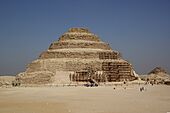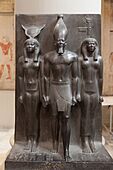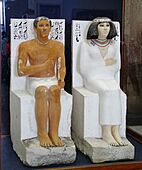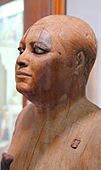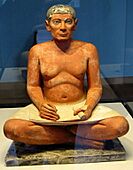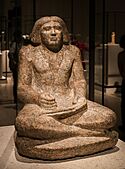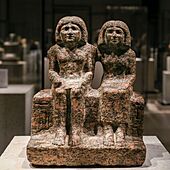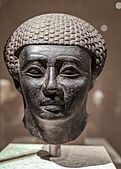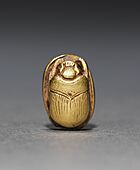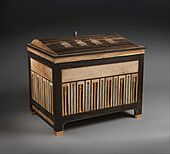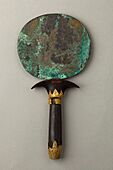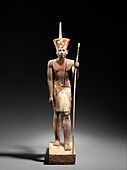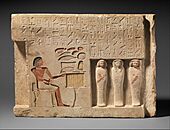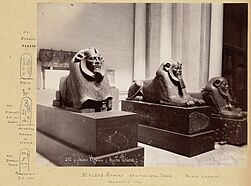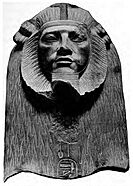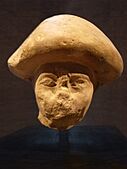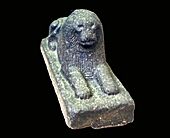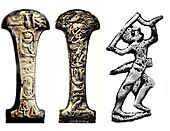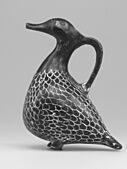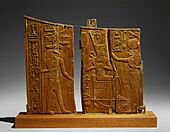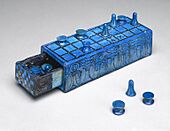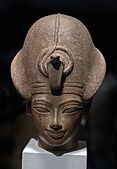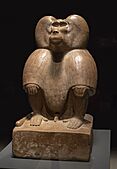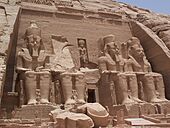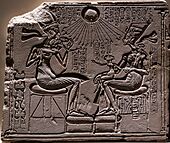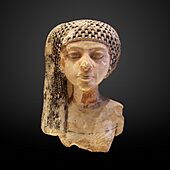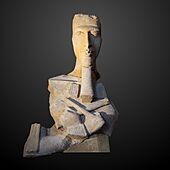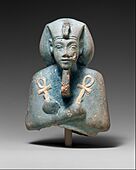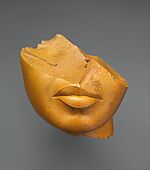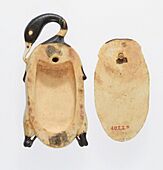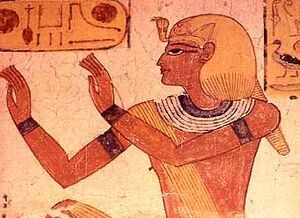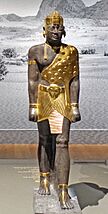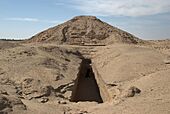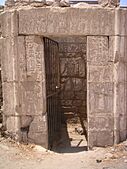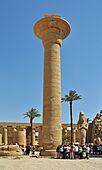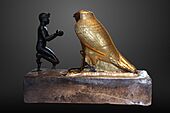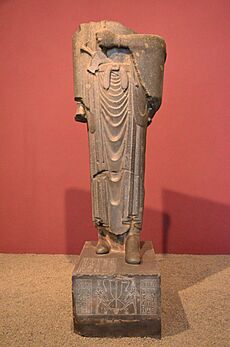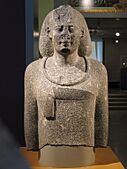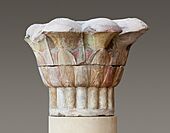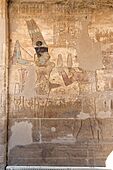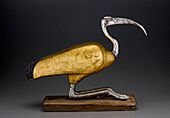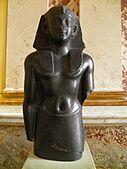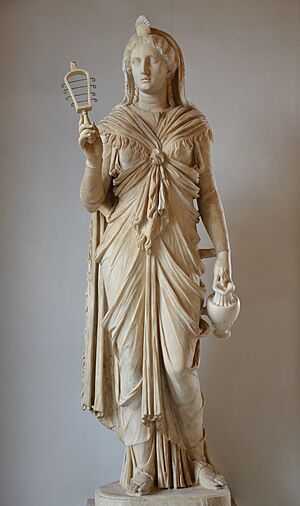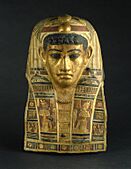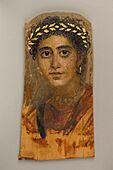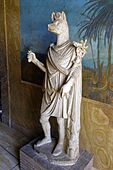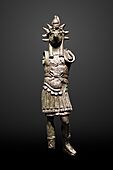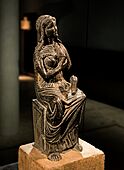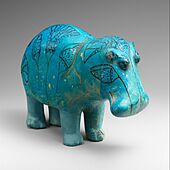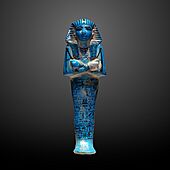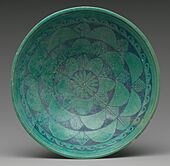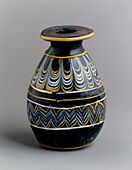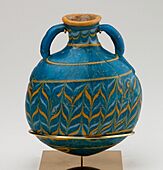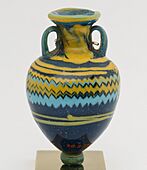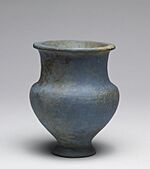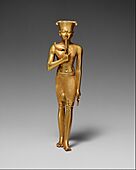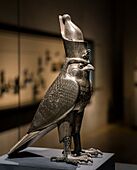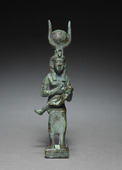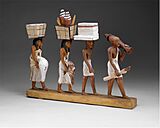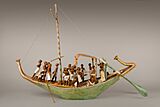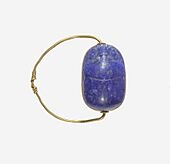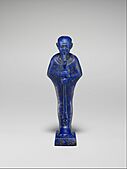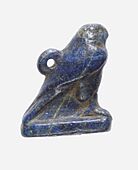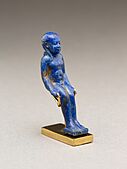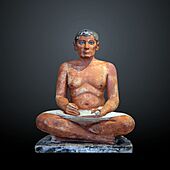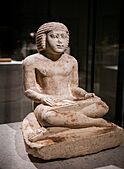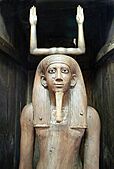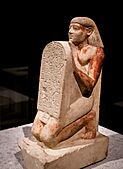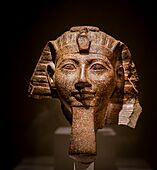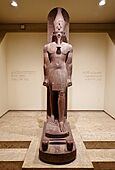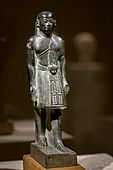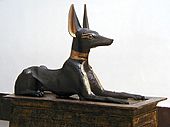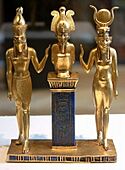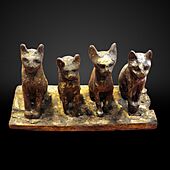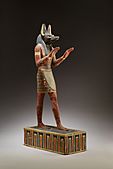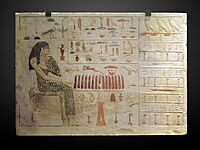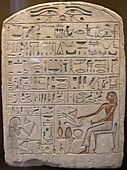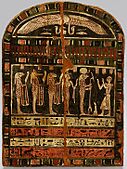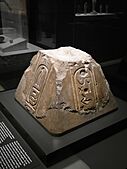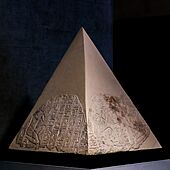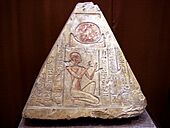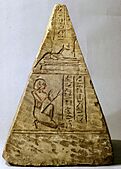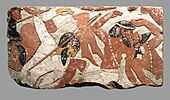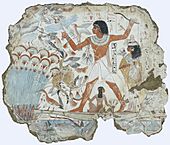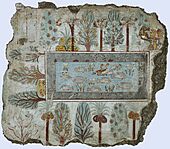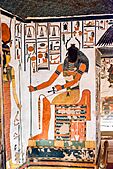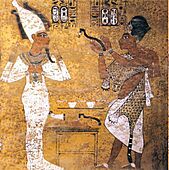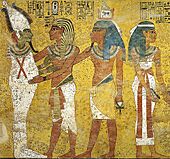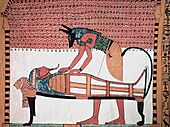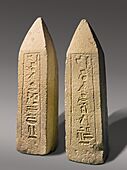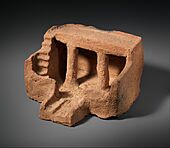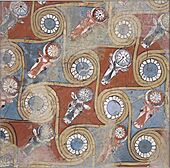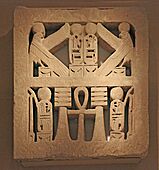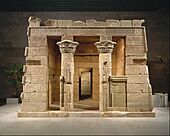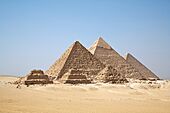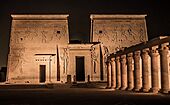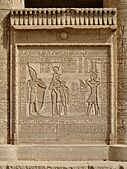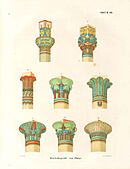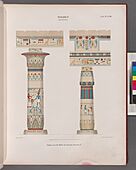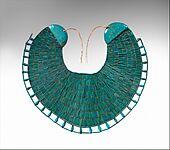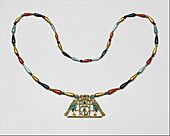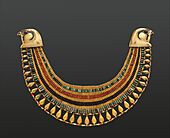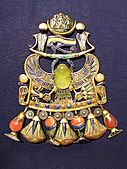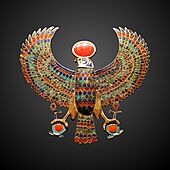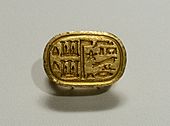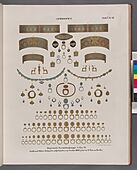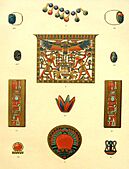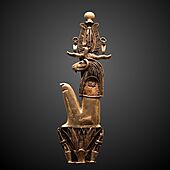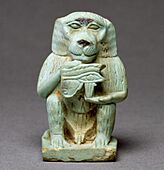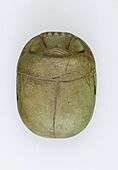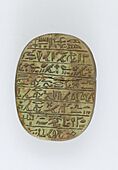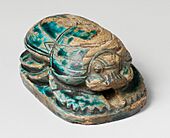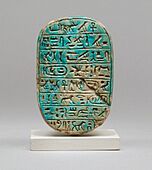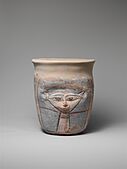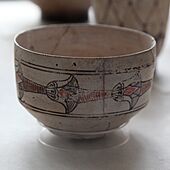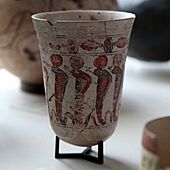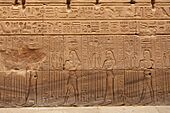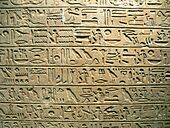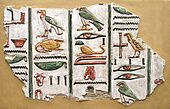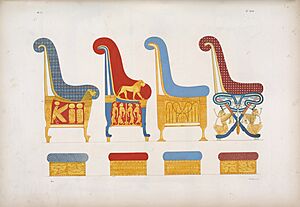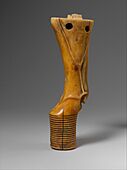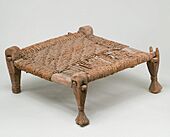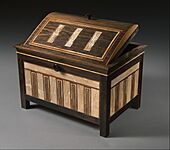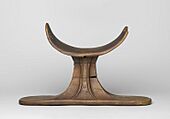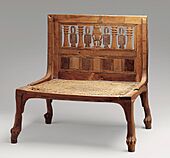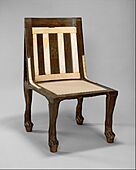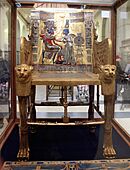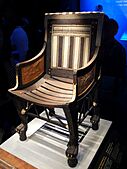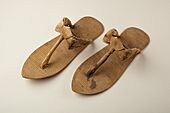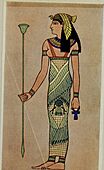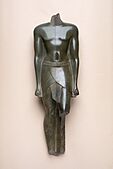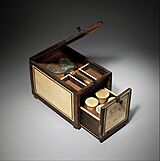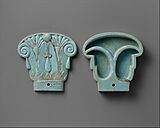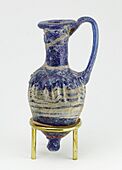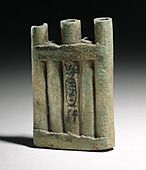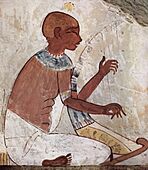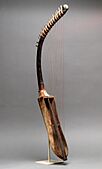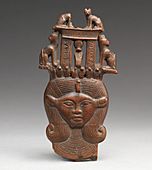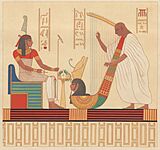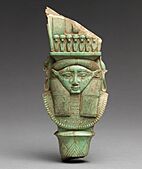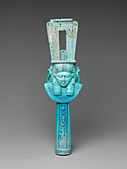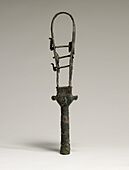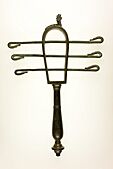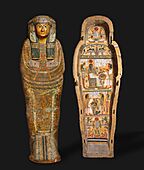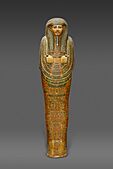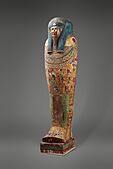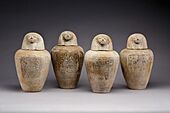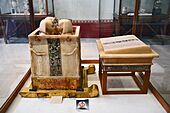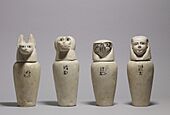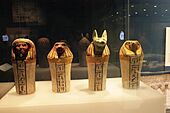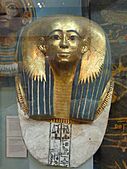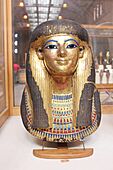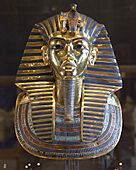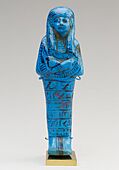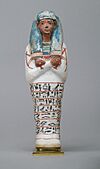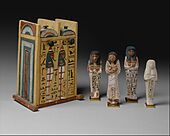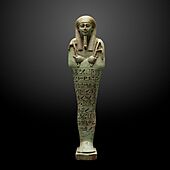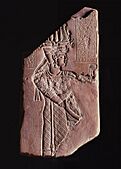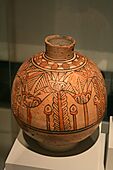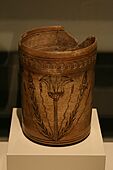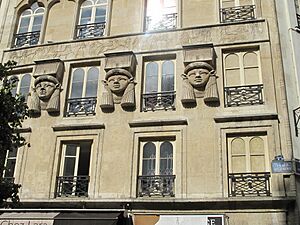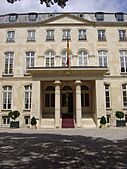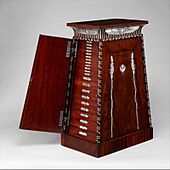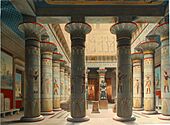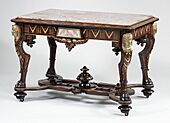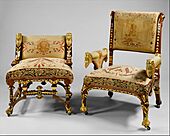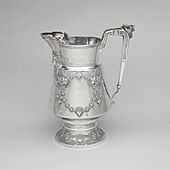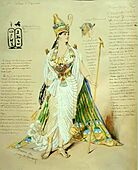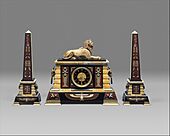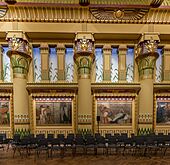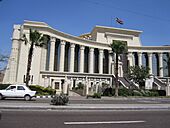Art of ancient Egypt facts for kids
Ancient Egyptian art is a fascinating journey through time! It includes amazing paintings, sculptures, drawings, jewelry, and grand buildings. This art was created in ancient Egypt from about 6000 BC until 400 AD. It was a very traditional style that didn't change much over thousands of years. Most of the art we find today comes from tombs and monuments. These artworks help us understand what ancient Egyptians believed about life after death.
For the Egyptians, art was more than just pretty pictures. It had a special purpose, often connected to their religion and beliefs. When artists created something, they wanted it to last forever. That's why Egyptian art often showed an ideal, perfect version of the world, not always how it looked in real life. Artists didn't usually sign their work. They believed art served a bigger purpose: to help keep the world in order, a concept they called Ma'at.
Contents
- Exploring Early Egyptian Art (6000–3000 BC)
- Art of the Pharaohs: Dynastic Egypt
- Early Dynastic Period (3100–2685 BC)
- Old Kingdom: The Age of Pyramids (2686–2181 BC)
- Middle Kingdom: Reunification and New Styles (c. 2055–1650 BC)
- Second Intermediate Period: Foreign Rulers (c. 1650–1550 BC)
- New Kingdom: Empire and Grandeur (c. 1550–1069 BC)
- Third Intermediate Period: A Return to Old Ways (c. 1069–664 BC)
- Late Period: Foreign Rule and Lasting Traditions (c. 664–332 BC)
- Ptolemaic Period: Greek Influence (305–30 BC)
- Roman Period: Mummy Portraits (30 BC–619 AD)
- Key Features of Egyptian Art
- Materials Used in Art
- Sculpture: Statues and Carvings
- Painting: Colors and Stories
- Architecture: Grand Buildings
- Jewelry: Adornment and Status
- Amulets: Magical Charms
- Pottery: Everyday and Funerary Uses
- Calligraphy: The Art of Hieroglyphs
- Furniture: Comfort and Craftsmanship
- Clothing: Simple and Elegant
- Cosmetics: Beauty and Protection
- Music: Sounds of Ancient Egypt
- Funerary Art: Preparing for the Afterlife
- Art of Meroë: Nubian Connections
- Egyptian Revival Art: Ancient Styles Inspire New Creations
- See also
Exploring Early Egyptian Art (6000–3000 BC)
Before the time of pharaohs and pyramids, early Egyptians lived along the Nile River. This period, called Pre-Dynastic Egypt, lasted from about 6000 BC to 3100 BC. During this time, people started farming and building small settlements.
Art from Early Settlements (5000–4000 BC)
The Merimde culture (around 5000–4200 BC) in Lower Egypt created simple pottery and small clay figures. They even made the first life-size clay head found in Egypt!
The Badarian culture (around 4400–4000 BC) made beautiful black-topped pottery. They also started using copper, a new material for tools and art.
Naqada Culture: Art Takes Shape (4000–3000 BC)
The Naqada culture is famous for its pottery and other artworks. It's divided into three parts: Naqada I, II, and III.
Naqada I: Decorated Pottery (4000–3500 BC)
During Naqada I, people continued making black-topped pottery. They also created "white cross-line ware," which had cool patterns of white lines.
Naqada II: New Influences (3500–3200 BC)
In Naqada II, art became even more detailed. Pottery was painted with animals, people, ships, and geometric designs. This period also shows signs of contact with other lands, like Mesopotamia. For example, the Gebel el-Arak Knife handle has carvings that look like Mesopotamian art. This suggests early trade and cultural exchange.
Naqada III: Unification and Royal Art (3200–3000 BC)
Naqada III is also called the Protodynastic Period. This is when Egypt started to become one unified country. We see the first signs of hieroglyphs (ancient Egyptian writing) and royal tombs. Art from this time, like fancy cosmetic palettes, became very detailed. These palettes, once used for makeup, became important ceremonial objects.
Art of the Pharaohs: Dynastic Egypt
Early Dynastic Period (3100–2685 BC)
After Egypt became one country, art continued to grow. Cosmetic palettes became even more detailed, and the Egyptian writing system developed further. Hieroglyphs started as simple symbols for amounts of things, then grew to include hundreds of symbols for sounds and ideas.
-
Both sides of the famous Narmer Palette, around 3100 BC.
Old Kingdom: The Age of Pyramids (2686–2181 BC)
The Old Kingdom is famous for its giant pyramids, like the Great Pyramid of Giza. This was a golden age for Egypt, and art from this time shows great skill. Kings like Sneferu perfected pyramid building. Statues from this period show strong, idealized figures of pharaohs and important people.
-
The Pyramid of Djoser at Saqqara, built around 2667–2648 BC.
-
The famous The Seated Scribe statue.
Middle Kingdom: Reunification and New Styles (c. 2055–1650 BC)
After a period of challenges, Egypt was reunited under kings like Mentuhotep II. Art in the Middle Kingdom returned to some Old Kingdom styles but also developed new features. Statues often showed more realistic faces, sometimes looking a bit serious or thoughtful. The god Osiris became very important in popular religion during this time.
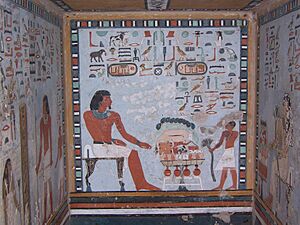
-
A statue of King Mentuhotep II, 2061–2010 BC.
-
A stone lintel showing King Amenemhat I with gods, 1981–1952 BC.
Second Intermediate Period: Foreign Rulers (c. 1650–1550 BC)
This was a time when foreign rulers, called the Hyksos, came from West Asia and took control of parts of Egypt. They didn't create much new art. Instead, they often put their names on older statues and monuments.
New Kingdom: Empire and Grandeur (c. 1550–1069 BC)
The New Kingdom was Egypt's most powerful and richest time. Kings built huge temples and created magnificent art. This wealth came from successful military campaigns and trade. Art from this period can be divided into Pre-Amarna, Amarna, and Ramesside styles.
Pre-Amarna: Hatshepsut's Legacy
This early part of the New Kingdom saw Egypt become a vast empire. Queen Hatshepsut (1473–1458 BC) was a powerful ruler who built many grand temples and statues. Her mortuary temple at Deir el-Bahri is a great example, with colorful reliefs showing her divine rule and expeditions.
State-Sponsored Temples
Kings built massive temples dedicated to the gods, like the one at Karnak for Amun-ra. These temples, made of strong stone and decorated with vibrant paintings, showed off Egypt's wealth.
-
A small statue (ushabti) of King Amenhotep II, 1427–1400 BC.
-
A gaming board for King Amenhotep III, 1390–1353 BC.
-
A head of King Amenhotep III, 1390–1352 BC.
-
The impressive Abu Simbel Temple of Ramesses II.
Amarna Art: A Unique Style (c. 1350 BC)
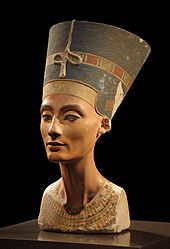
King Akhenaten introduced a new religion focused on the sun god, Aten. This led to a very different art style, known as Amarna art. It showed more movement and a "realer" view of people. Akhenaten himself was often shown with unusual features, like a long chin and full lips. His family, including Queen Nefertiti, was also shown in this unique style. After Akhenaten's death, artists quickly went back to the traditional Egyptian styles.
-
A portrait of Meritaten, 1351–1332 BC.
-
A statue of Akhenaten, around 1350 BC.
-
A talatat block showing Akhenaten praying to the sun god Aten, around 1350 BC.
Ramesside Period
After the Amarna period, art returned to traditional forms, especially honoring the god Amun-ra. Kings like Ramesses II continued to build massive temples and colossal statues. The Great Hypostyle Hall at Karnak, with its many huge columns, is a stunning example of this period's grand architecture.
Third Intermediate Period: A Return to Old Ways (c. 1069–664 BC)
This was a time of political challenges for Egypt. Art often looked back to the styles of the Old and Middle Kingdoms. Later, Nubian kings, sometimes called "Black Pharaohs," ruled Egypt. They brought back traditional Egyptian values and art, adding some unique Nubian touches.
-
The pyramid of Piye, a Nubian king, at El-Kurru.
-
Taharqa offering wine jars to the Falcon-god Hemen, 690–664 BC.
Late Period: Foreign Rule and Lasting Traditions (c. 664–332 BC)
Egypt faced rule by Persians during this period. Despite political changes, Egyptian art and culture continued to thrive. Temples built during this time still followed traditional Egyptian styles, showing little foreign influence. Horus stelae, stone tablets depicting the god Horus with snakes, became common for protection.
Ptolemaic Period: Greek Influence (305–30 BC)
After Alexander the Great conquered Egypt, the Ptolemaic dynasty (Greek rulers) took over. While court art sometimes mixed Greek and Egyptian styles, temples in the countryside mostly kept to traditional Egyptian art. Marble was used more, and queens were often shown with great importance.
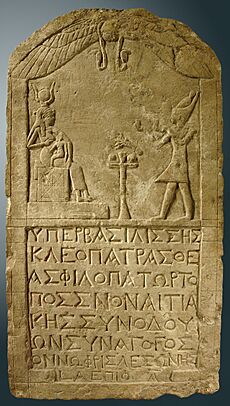
Roman Period: Mummy Portraits (30 BC–619 AD)
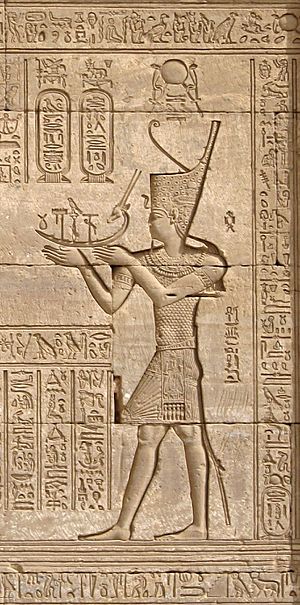
The Fayum mummy portraits are the most famous art from Roman Egypt. These were realistic painted portraits on wooden boards attached to mummies of wealthy people. They show a blend of Egyptian burial customs and Roman painting styles. These portraits are important because they are some of the few surviving examples of ancient panel painting.
Key Features of Egyptian Art
Unique Figure Conventions
Egyptian art has a very distinct way of showing people. In paintings and reliefs, important figures often have their head and legs shown from the side, but their body from the front. Men were usually painted darker than women. The size of a figure showed their importance: gods and pharaohs were largest, while servants were smallest.
Artists' Anonymity
Ancient Egyptian artists rarely signed their work. Art was often a team effort, and its purpose was more important than individual fame.
Powerful Symbolism
Symbols were everywhere in Egyptian art. A pharaoh's crown or staff showed his power. Animals were also very symbolic. Colors had special meanings too:
- Blue meant fertility, birth, and the life-giving Nile.
- Green symbolized new life and rejuvenation.
- Black represented the fertile soil of the Nile and the afterlife.
- Gold showed divinity and was considered the "flesh of the gods."
- Red was linked to the sun and also to the desert god Set.
Materials Used in Art
Ancient Egyptians were skilled at using many different materials for their art.
Faience: Dazzling Ceramics
Faience is a shiny, ceramic-like material made from quartz sand. It was often blue-green, like turquoise or lapis lazuli, but cheaper. Egyptians used it for small objects and inlays.
-
William the Faience Hippopotamus, 1961–1878 BC.
Glass: A Royal Material
Glassmaking became popular in the New Kingdom. It was expensive and rare, often used for royal items. Egyptians made beautiful glass bottles and other objects.
Egyptian Blue: A Special Pigment
Egyptian blue is a unique blue pigment and material. It was made by heating quartz, alkali, and copper. It was used for statuettes and as a color in paintings.
Metals: Gold, Silver, and Copper
Egyptians used metals like copper, gold, and silver. Copper was used for tools and large statues. Gold was very important, symbolizing divinity and used for royal treasures like Tutankhamun's mask. Silver was rarer than gold and also highly valued. Iron was used later, mostly for tools and weapons.
-
An Amun-Ra figurine made of silver and gold, 1069–664 BC.
-
A gold statuette of Amun, 945–715 BC.
-
A silver and electrum figurine of Horus, around 500 BC.
Wood: Furniture and Figurines
Wood was used for furniture, small statues, and models placed in tombs. Native trees like date palm and sycamore fig were used, but finer woods were imported.
-
A painted wooden figurine of Isis, Ptolemaic dynasty.
Precious Stones: Lapis Lazuli and Turquoise
Lapis lazuli, a deep blue stone, was highly valued for its connection to the heavens. It was imported from Afghanistan. Turquoise, a blue-green stone, was linked to the goddess Hathor and symbolized renewal. Other stones like jasper and serpentine were also used for jewelry and amulets.
-
A cult image of Ptah made with lapis lazuli, 945–600 BC.
Sculpture: Statues and Carvings
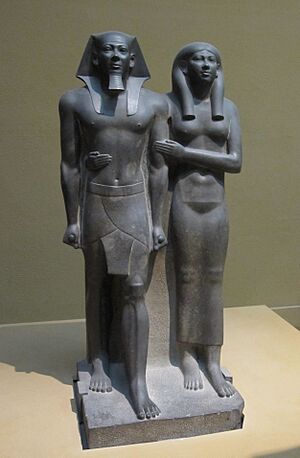
Egyptian sculptors created monumental statues for temples and tombs, as well as delicate small works. They often used a technique called sunk relief, where carvings are cut into the surface. Standing statues usually faced forward with one foot slightly ahead, a pose that gave them balance and strength. This style remained consistent for thousands of years.
Pharaohs were seen as gods, and their statues were often huge. The famous four colossal statues outside the main temple at Abu Simbel show Ramesses II. Temples also had avenues lined with sphinxes and other animal statues.
Special statues called Ka statues were placed in tombs. They were meant to be a resting place for the ka (a part of the soul) of the deceased. These statues, sometimes made of wood, could be very realistic. Small figures of gods, animals, and servants were also common, providing for the afterlife.
Sculptors followed strict rules for depicting gods. For example, the sky god Horus always had a falcon's head, and Anubis, the god of funeral rites, had a jackal's head. These rules helped convey the timeless nature of the figures.
-
Both sides of the Narmer Palette, showing early Egyptian figure style, around 3100 BC.
-
The Seated Scribe, a famous painted limestone statue, 2613–2494 BC.
-
A portrait head of Pharaoh Hatshepsut or Thutmose III, 1480–1425 BC.
-
A large statue of Amenhotep III, 1390–1352 BC.
-
The Anubis Shrine from Tutankhamun's tomb, 1336–1327 BC.
-
A painted wooden statuette of Anubis, 332–30 BC.
Stele: Stone Tablets with Stories
A stele is an upright stone or wooden tablet, often carved with text and pictures. They were used for many purposes:
- Funerary stelae identified tomb owners and ensured offerings in the afterlife.
- Votive stelae had prayers to gods, hoping for good outcomes.
- Commemorative stelae celebrated achievements, victories, or marked borders.
-
A painted limestone stela of Pepi, chief of potters, 8th century BC.
Pyramidia: Pyramid Capstones
A pyramidion is the capstone at the very top of a pyramid. It was called benbenet and connected the pyramid to the sacred Benben stone. These capstones might have been covered in gold to reflect the sun's rays.
Painting: Colors and Stories
Egyptian paintings decorated tombs, temples, and palaces. Artists prepared stone walls with plaster, then applied mineral pigments that wouldn't fade in the strong sunlight. They painted on dry plaster, not wet. A varnish was often added to protect the artwork.
Many paintings survived in tombs because of Egypt's dry climate. These paintings often showed scenes for a happy afterlife, like journeys through the underworld or meeting gods. Some depicted activities the deceased enjoyed in life.
Egyptian paintings have a unique style: they show a side view and a front view of a person or animal at the same time. For example, a head might be in profile, but the body facing forward. Main colors included red, blue, green, gold, black, and yellow.
-
Frescoes in the Tomb of Nefertari, showing Khepri.
-
A wall painting from Tutankhamun's tomb.
-
A scene from Tutankhamun's tomb showing Osiris.
-
A wall painting from the tomb of Sennedjem showing Anubis.
-
The Book of the Dead of Hunefer, around 1275 BC.
Architecture: Grand Buildings
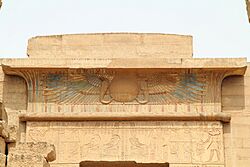
Ancient Egyptian architects used sun-dried bricks and strong stones like sandstone, limestone, and granite. They planned everything carefully, fitting stones precisely without mortar. The exterior walls of pyramids had few openings. Hieroglyphic carvings and colorful pictures decorated structures, often showing pharaohs becoming gods.
Early architects like Imhotep used stone columns carved to look like bundles of reeds or plants. These columns were highly decorated with hieroglyphs, texts, and natural designs. The columns at Luxor Temple resemble papyrus bundles, symbolizing the marsh where Egyptians believed the world began.
-
A pair of obelisks, 2323–2100 BC.
-
A ceiling painting from the palace of Amenhotep III, around 1390–1353 BC.
-
A column with a Hathor-emblem capital, 380–362 BC.
-
A relief from the Dendera Temple complex.
-
Illustrations of columns from the Temple of Ramesses II.
Jewelry: Adornment and Status
Ancient Egyptians loved to wear jewelry and decorate themselves. Early burials contained beads made from stone, shell, and ivory. Gold, silver, copper, and faience jewelry also appeared early on. By the Old Kingdom, combinations of carnelian, turquoise, and lapis lazuli were popular for royal jewelry.
Jewelry showed off wealth and rank. Royal jewels were the most elaborate, often found in tombs of princesses. Necklaces, bracelets, armlets, and broad collars were always popular. In the Middle Kingdom, finger rings and ear ornaments became fashionable. New Kingdom jewelry was even more detailed and colorful, influenced by styles from Greece and the Levant. Many beautiful pieces were found in Tutankhamun's tomb.
-
A pectoral and necklace of Princess Sithathoriunet, 1887–1813 BC.
-
A pectoral of Tutankhamun, 1336–1327 BC.
Amulets: Magical Charms
Amulets were small charms worn for magical protection or to bring certain qualities, like strength. They were used by both the living and the dead. Specific amulets were placed in mummy wrappings. They were made from various materials, including faience, glass, and precious stones, with colors often playing a symbolic role.
-
An amulet of Thoth as a baboon, 664–332 BC.
Scarab-Shaped Amulets
The scarab beetle was a powerful symbol of new life and resurrection. Egyptians believed the beetle rolled the sun across the sky, just as it rolled balls of dung. Large scarab amulets, called heart scarabs, were placed over the heart of the deceased in mummy wrappings for protection in the afterlife.
-
A commemorative scarab of Amenhotep III, 1390–1352 BC.
Pottery: Everyday and Funerary Uses
Pottery was used for everyday items and for special objects placed in tombs. Some pottery jars stored internal organs removed during mummification. Tomb walls were sometimes decorated with pottery cones inscribed with information about the deceased.
Calligraphy: The Art of Hieroglyphs
Egyptian writing, known as hieroglyphs, was a complex system of symbols. It appeared around 3200 BC and was used for monumental inscriptions. Hieroglyphs were beautifully carved on stelae and temple walls, telling stories and recording history.
-
Hieroglyphs from the tomb of Seti I.
Furniture: Comfort and Craftsmanship
Ancient Egyptians were skilled woodworkers. They made chairs, stools, beds, and chests. Chairs were mostly for the wealthy, while most people used low stools. Royal furniture was very elaborate, with inlays of ivory, gold, and precious stones. The furniture from Tutankhamun's tomb shows incredible craftsmanship.
-
The Throne of Tutankhamun, 1336–1327 BC.
Clothing: Simple and Elegant
Egyptian clothing was usually simple, made of linen, and often white. Men wore loincloths or short kilts. Women wore tight-fitting dresses. Wealthy people wore more elaborate, pleated robes, especially in the New Kingdom. Jewelry and colorful bead netting often enhanced outfits.
Cosmetics: Beauty and Protection
Makeup was a key part of ancient Egyptian culture. Black kohl (eye-paint) was used to protect the eyes from the sun and for beauty. It was made from galena. Green eye-paint from malachite was also used. Women painted their lips and cheeks with red ochre. Henna dyed hair and nails. Creams and oils kept skin healthy.
Music: Sounds of Ancient Egypt
Music was important for celebrations and religious events. Musicians played instruments like castanets, flutes, drums, tambourines, and harps. The lyre and lute were introduced from other lands. Women singers and sistrum players had important roles in temple rituals.
-
An illustration of a harper playing for the god Shu.
Sistrum: A Sacred Rattle
A sistrum was a rattle used in religious ceremonies, especially by women. Its name imitated the swishing sound of its metal disks. It was linked to the goddess Hathor, often decorated with her image.
-
A sistrum decorated with a Hathor face, 664–332 BC.
-
A sistrum inscribed with the name of Ptolemy I, 305–282 BC.
Funerary Art: Preparing for the Afterlife
Coffins: Homes for the Soul
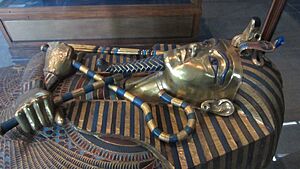
Coffins were essential for burials, providing a home for the ka and protecting the body. Early coffins were simple wooden boxes. Later, they became more elaborate, decorated with texts and images of offerings. Some coffins had eyes painted on the side so the deceased could look towards the rising sun. Wealthy individuals often had sets of nested coffins, sometimes made of gold or silver.
Canopic Jars: Protecting Organs
Canopic jars were special vessels used to store the internal organs (liver, lungs, stomach, intestines) removed during mummification. Each jar was protected by one of the Four sons of Horus. The stoppers of these jars were often shaped like human or animal heads.
-
Canopic jars of Tutankhamun, 1333–1323 BC.
Masks: Transformation to Divine
Funerary masks were used in all periods. They ranged from the gold masks of Tutankhamun to the Roman "mummy portraits." The purpose of a mask was to help transform the deceased from a mortal to a divine being.
Ushabti: Servants for the Afterlife
Ushabtis were small funerary figurines. Their job was to act as substitutes for the deceased if they were called upon to do work in the afterlife. They often had inscriptions detailing their duties.
Art of Meroë: Nubian Connections
Ancient Egypt had a long history with the region to its south, called Nubia. Nubian culture, especially the Kingdom of Kush, adopted many Egyptian art styles and ideas. This created a rich mix of African and Egyptian influences in their art.
Egyptian Revival Art: Ancient Styles Inspire New Creations
Egyptian Revival art is a style that became popular in Western art, especially in the 1800s. People started using Egyptian designs like obelisks, hieroglyphs, sphinxes, and pyramids in architecture, furniture, and other decorative items. This interest grew after Napoleon's expedition to Egypt in the late 1700s. Egyptian styles offered an exciting alternative to traditional designs.
-
The Supreme Constitutional Court of Egypt.
See also
- History of art
- Ancient art


